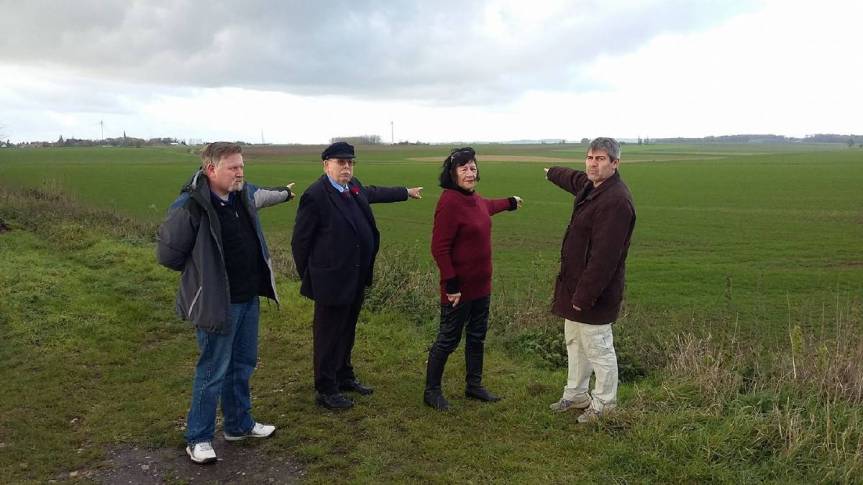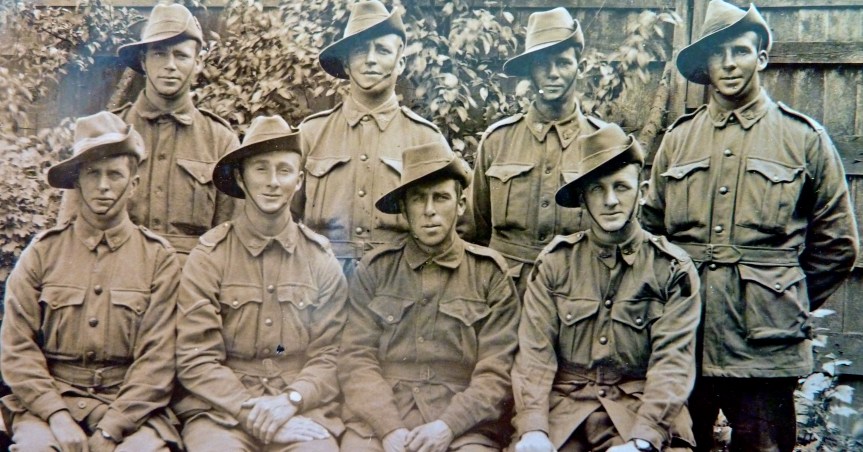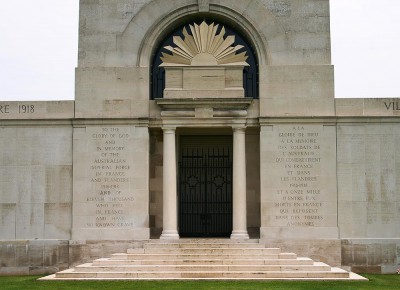
STT has already set out the background to what amounted to an appalling affront to the 11,000 Australians who were killed in France and Belgium and who have no known grave – here: Shameless: French Wind Power Outfit, Engie Determined to Desecrate Battlefield Graveyard
And we covered the efforts of their Australian descendants fighting to keep Australia’s most hallowed ground that way, forevermore – here: Outrageous Wind Farm Plan for Battlefield Graveyard Draws Fury from French & Australians
Those efforts were equally matched by local French men and women, who shared in the outrage expressed by Australians here, as well as those Australians who descended on the battlefields of France to prevent the desecration of what is a National Cemetery.
STT is delighted to report that those noble efforts have, this time, proved entirely successful.
French wind power outfit, ENGIE (which also operates in Australia) has finally relented, withdrawing its plan to spear six turbines into the Bullecourt battlefield.
Diggers can rest in peace after Bullecourt wind farm plan scrapped
The Australian
Sam Buckingham-Jones
20 November 2017
The remains of thousands of Diggers who died in the brutal World War I battle of Bullecourt in France will remain at rest after plans to build a giant wind farm at the historic site were abandoned following a campaign from the soldiers’ families.
The company that wanted to install six giant turbines at Bullecourt in northern France, where Australia suffered 10,000 casualties, now says the battleground should “remain undisturbed” more than two years after it first put forward the idea.
The turbines were to be installed by French power firm ENGIE Group at the scene of bloody battles in April and May of 1917.
“I couldn’t be more relieved,” Ashley Starkey, whose great-great-uncle Valentine Montgomery Starkey fell at Bullecourt. “It’s heartwarming to think a small group of Australians and French locals could get such a momentous change in two weeks since we started a small campaign.”
In a letter obtained by The Australian from ENGIE’s Australia and New Zealand chief executive, Michel Gantois, to Veterans’ Affairs Minister Dan Tehan, Mr Gantois confirmed the project would “not proceed”.
“On behalf of the ENGIE Group, I am very pleased to inform you that this development will now not proceed,” he wrote. “ENGIE Green listened carefully and respectfully to the arguments put forward and has decided that this ground should remain undisturbed, to be a place of reflection and commemoration for generations to come.”
Mr Tehan personally spoke to French officials, including his counterpart in France, Genevieve Darrieussecq, the secretary of state to the French Minister for Armed Forces, and the French ambassador to Australia, Christophe Penot, to express his strong opposition to the project.
Today, Mr Tehan thanked ENGIE Group for its decision.
“Seeing how passionate Australians were about protecting the final resting place of the Bullecourt soldiers was a powerful reminder that we will never forget the service and sacrifice of the men and women who fight for our freedom and values,” he said.
“This is wonderful news for every Australian and especially those with a family connection to the Battle of Bullecourt. Some 3,300 Australians who died at Bullecourt have no known grave and Australians were rightly concerned about the potential impact of a construction project at the site.”
War historian CEW Bean described Bullecourt as a pivotal debacle that caused Australians to demand they control their soldiers rather than being subject to British command.
It was to be the first time an Australian infantry attack used the protection of tanks, but they were ineffective and, because the attack was supposed to be a surprise, there was no covering artillery bombardment. It has been estimated the remains of between 3000 and 4000 Australian, British and German soldiers were never recovered.
The wind turbine project had been in the pipeline for more than 2½ years. The company behind the initial plans, Maia Eolis, said it sent a letter in February 2015 to Stephen Brady, the Australian ambassador to France, asking to meet and discuss the project.
The letter was either lost, forgotten, or did not arrive, as Mr Tehan first heard about it in the past few months. ENGIE acquired Maia Eolis in March last year. The campaign was instigated by former Queensland premier Campbell Newman, whose great-uncle, Second Lieutenant Leslie Mullett, was killed in action. “He was listed as missing in action but they never found him,” he said earlier this month. “There were descriptions later of horrific scenes of bodies hanging up on the barbed wire.” Mr Newman described the plans as “the same as someone carving a trench through the Lone Pine cemetery and putting up a wind farm”.
Fighting in the 14th Battalion alongside Mullett was Albert Jacka, the first Australian to receive the Victoria Cross in World War I, for his actions at Gallipoli. Jacka was later decorated twice for bravery on the Western Front.
Ashley Starkey, a documentary-maker, discovered his family’s connection to the area when he was first showing the internet to his grandfather, who was named Valentine after his uncle.
The 98-year-old’s first thoughts were to Google his namesake.
“I only found out he was killed in this battle two weeks before I went to France,” Starkey said. “It took 100 years for our family to find out what happened to him, and to have had the site destroyed would have been very distressing.”
Australian War Memorial director Brendan Nelson criticised ENGIE for pursuing the project this far. “My strong advice to ENGIE’s executives is to desist from its insensitivity to those who gave their lives for the freedom of France,” he said.
The Australian

again to save our most hallowed ground.
Bullecourt battleground must be off-limits: Newman
The Australian
Stephen Fitzpatrick
22 November 2017
Protections should be put in place so the World War I battleground of Bullecourt in France can never be subject to development, former Queensland premier Campbell Newman has suggested after plans were abandoned this week for a wind farm on the site.
Mr Newman also called for a proper investigation into claims the area in northern France, where Australia suffered 10,000 casualties in two battles in 1917, contained numerous unmarked mass graves.
It has been estimated the remains of 3000-4000 Australian, British and German soldiers were never removed from the site.
“It’s a terrific decision by (French firm) ENGIE not to go ahead with the project, and I extend my thanks to them for being responsible corporate citizens, as well as to everyone else who has helped make this happen,” he said.
“But we still need to go further. I’ve no wish to compromise the ability of French farmers to work their fields as they have done for generations, and in fact I take my hat off to them because they are acutely aware of the responsibility to our dead.
“But this outcome is simply because the company concerned made the decision not to proceed; it could be a different company in the future. So we need some kind of measure in place to protect the Bullecourt battlefield.
“I’m calling for protection for this very historic sacred site to Australians and British as well as Germans who lost servicemen.”
Mr Newman cited an account by Digger Fred Peachey, who was taken prisoner during the first battle of Bullecourt on April 11, 1917. Peachey later told the Australian War Office he was ordered at gunpoint by a German NCO to retrieve the bodies of dead Australians, remove items of value other than their identification tags and bury them in shell holes, with up to 30 bodies in each hole.
“After this was done we had to remove our wounded, who had been left in the barbed wire. Those who had leg wounds and could not walk were shot with a revolver through the head,” Peachey said.
Mr Newman said it was time for a formal investigation into the presence of such mass graves.
“My view is we should have a project starting with a study to find our lost Diggers,” he said. “We know we’ve got many Diggers lying in that field whose remains haven’t been found, and I’m putting forward in a respectful way we should find them. That’s what we did at Fromelles.”
The Australian

Former Queensland Premier, Campbell Newman is right to look beyond Bullecourt.
The War to end all Wars left 46,000 Australian men resting in French soil and 11,000 of those without any known grave.
Previously, French wind power outfits have threatened turbines for Villers-Brettoneux, only to scrap those plans after creating an uproar amongst Australians and French, alike.
Across the globe, wind power outfits are peopled by shameless sociopaths, who have no respect for life or liberty, and no sense of moral decency, wherever they ply their subsidy-soaked trade.
War Memorial director Brendan Nelson’s pointed attack on ENGIE for pursuing the project as far as it did is worth repeating: “My strong advice to ENGIE’s executives is to desist from its insensitivity to those who gave their lives for the freedom of France.”
That advice would bear fruit when given to anyone gifted with a conscience.
As STT followers are acutely aware those that people the wind industry are utterly devoid of the traits one expects from civilised beings.
STT is happy to chalk this one up as a victory. However, that it required an all-out effort to prevent the desecration and destruction of thousands of battlefield graves speaks volumes about the wind industry.
Left to its own devices, the French wind industry will never let the 11,000 AIF men lying tomb-less in French fields rest in peace.
Ensuring that they do is down to people equipped with moral decency and courage.
STT salutes all those Australians who helped to save Bullecourt’s battlefield graveyard and thanks the marvelous French, who still revere the 46,000 Australians who gave their lives for France a Century ago.

who died for France with no known grave.

Reblogged this on ajmarciniak and commented:
STT has already set out the background to what amounted to an appalling affront to the 11,000 Australians who were killed in France and Belgium and who have no known grave – here: Shameless: French Wind Power Outfit, Engie Determined to Desecrate Battlefield Graveyard
And we covered the efforts of their Australian descendants fighting to keep Australia’s most hallowed ground that way, forevermore – here: Outrageous Wind Farm Plan for Battlefield Graveyard Draws Fury from French & Australians
Those efforts were equally matched by local French men and women, who shared in the outrage expressed by Australians here, as well as those Australians who descended on the battlefields of France to prevent the desecration of what is a National Cemetery.
STT is delighted to report that those noble efforts have, this time, proved entirely successful.
French wind power outfit, ENGIE (which also operates in Australia) has finally relented, withdrawing its plan to spear six turbines into the Bullecourt battlefield.
Reblogged this on Patti Kellar and commented:
Good news they stopped this wind farm which would desecrate the ground and freedom so many gave their lives for. Now if the powers that be had some respect and consideration for the living, we’d be all set!
Typical blowin Tehan, more concerned about people across the other side of the world, than people in his flying safe seat. When his time is up he’ll go back to Toorak.